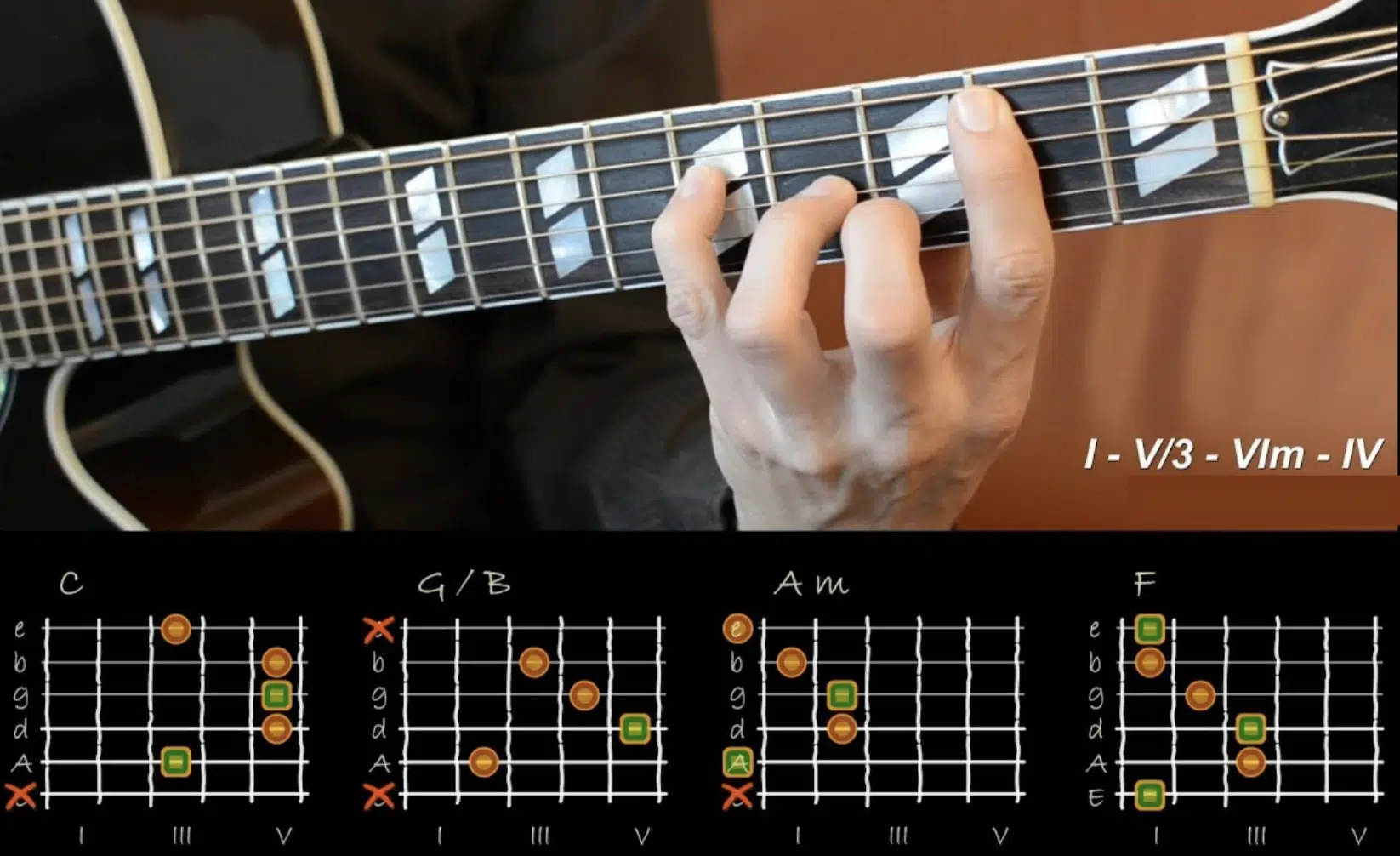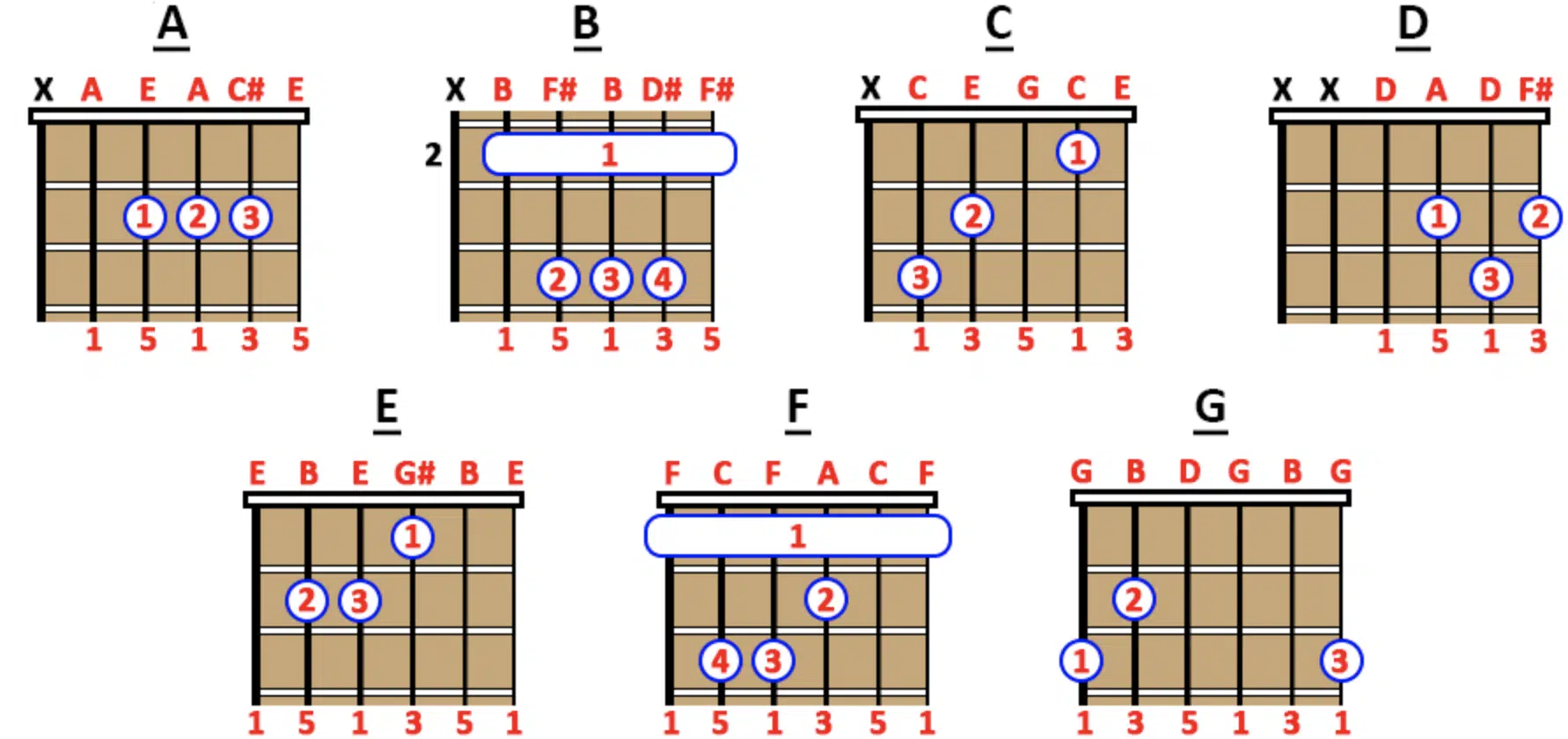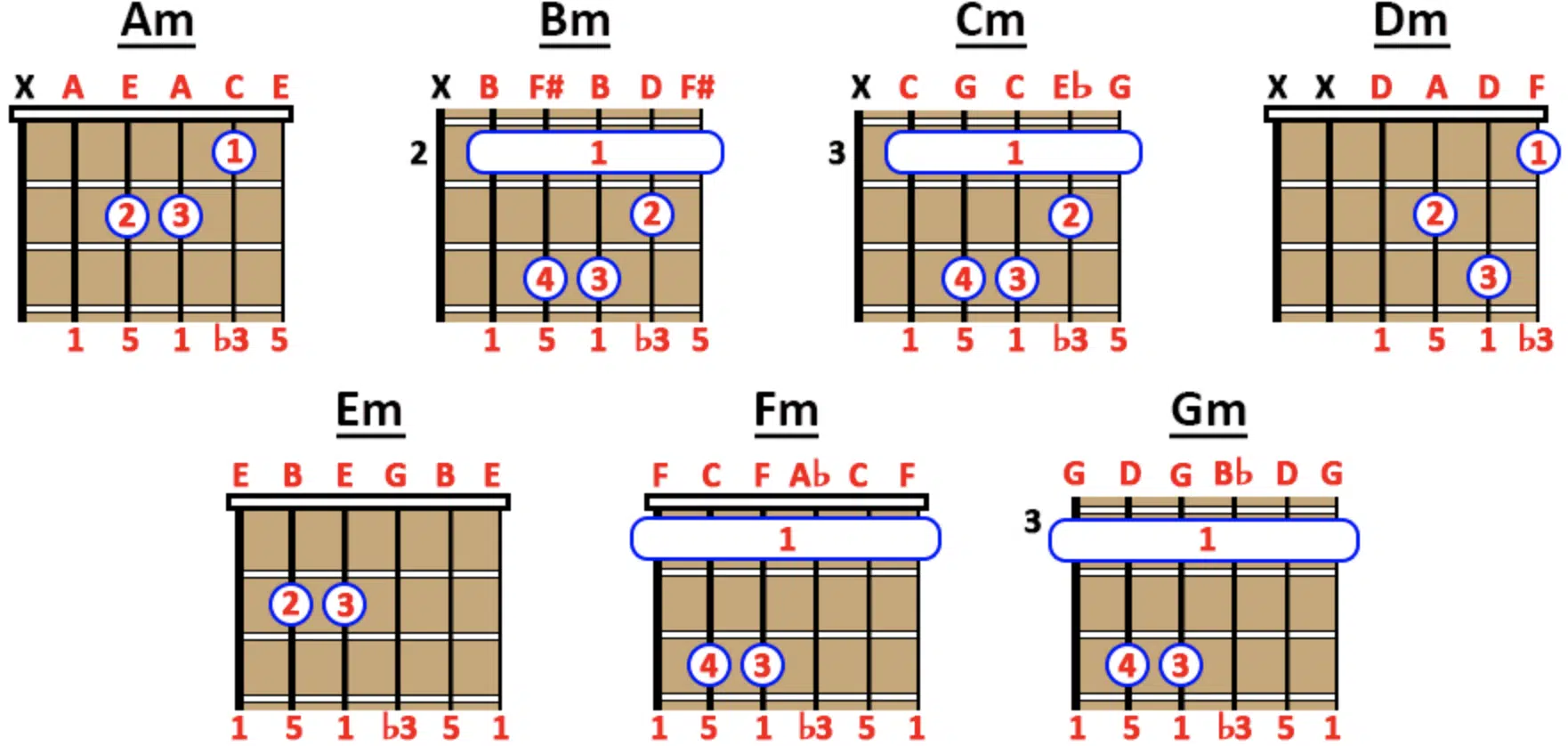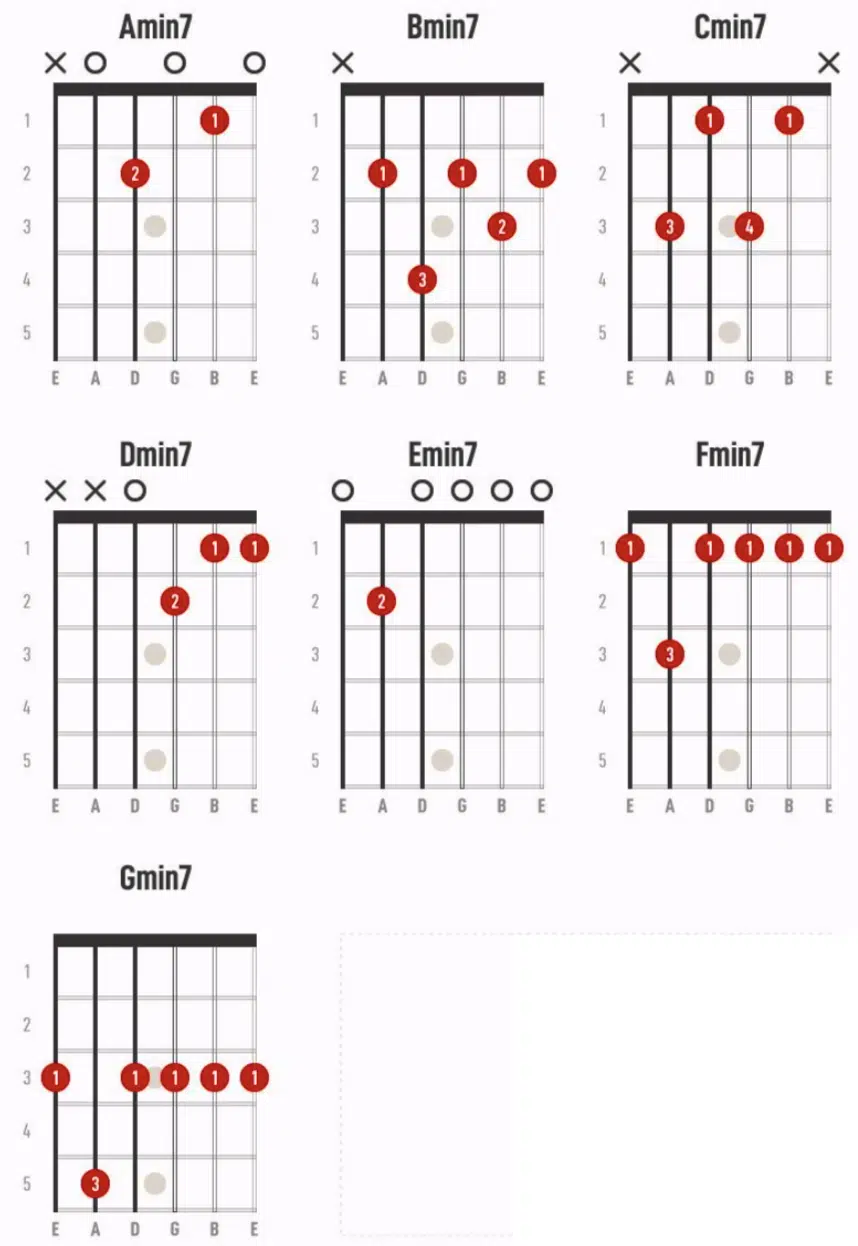Guitar playing requires not just passion and creativity, but also a solid foundation in the basics of music theory and technique.
That’s where chord progressions come in 一 providing structure and harmony that guides the melody and captivates your audience.
Understanding and mastering these progressions can elevate your guitar playing from simple strumming to legendary in no time.
So, if you’re a beginner guitar player, it’s important to know some easy chord progressions to kick off your journey, which is exactly what we’re covering today.
In today’s article, we’ll be breaking down:
- The 10 most common chord progressions for beginners ✓
- Major chords, minor chords, and other chords ✓
- Tips on mastering barre chords ✓
- Using a guitar chord progression chart ✓
- Techniques for smooth chord transitions ✓
- Creative ways to experiment with different progressions ✓
- How to start creating your own music ✓
- Much more about different chord progressions ✓
You’ll have the knowledge and confidence to start practicing these impactful, yet easy chord progressions.
Plus, discover how certain sequences of chords can evoke emotions, drive the rhythm of songs, and form the basis for countless hits across various genres.
By the end, you’ll have the skills to experiment with creating your own music that sounds like you’ve been at it for years.
So, let’s dive in…
Table of Contents
- Understanding Chord Progressions
- Major Chords vs. Minor Chords
- The Building Blocks of Guitar Chord Progressions
- 10 Easy Guitar Chord Progressions For Beginners
- #1. Doo-Wop Progression (I-vi-IV-V)
- #2. The Three-Chord Trick (I-IV-V)
- #3. The 12-Bar Blues (I-I-I-I-IV-IV-I-I-V-IV-I-I or V)
- #4. The ii-V-I Progression
- #5. The vi-IV-I-V Progression
- #6. The I-V-vi-IV Progression
- #7. The I-IV-vi-V Progression
- #8. The I-V-IV Progression
- #9. The I-vi-ii-V Progression
- #10. The I-iii-IV-V Progression
- Using a Chord Progression Chart
- How to Move Between Chords Smoothly
- Easy Chord Progressions: Final Thoughts
Understanding Chord Progressions

Understanding chord progressions is essential for anybody who wants to play guitar.
Essentially, a chord progression is a sequence of chords played in a specific order, creating the harmonic foundation of a song.
These common chord progressions help you set the mood and direction of the music, which makes them a key element of guitar playing.
For beginner guitar players, mastering the concept of easy chord progressions, such as the classic C-G-Am-F, helps you play along with popular songs and enhance your skills.
Breaking down chord progressions so they are second nature goes beyond recognizing sequences like the Doo-Wop progression (I-vi-IV-V) or the famous I-V-vi-IV…
It involves seeing the relationship between different chords and how they contribute to the overall feel/vibe of a song.
For example, the transition from a G major chord to a C major chord (G to C) feels natural and uplifting, thanks to their harmonic relationship within the key of G major.
Also, moving from a chord rooted in the major scale to a minor chord, such as from C major to A minor (C to Am), introduces a subtle shift in emotion.
Whether it’s a simple three-chord song or a more complex variation, the progression of chords is your golden ticket to guitar mastery.
Major Chords vs. Minor Chords
One fundamental distinction in music theory is between major and minor chords.
Don’t worry, we’ll break it down more in the following section, but here is a quick recap of major chords vs minor chords.
-
Major Chords

Major chords are often described as happy, bright, or uplifting. For instance, the G major chord, with its open, resonant sound, is a staple in various genres.
-
Minor Chords

Minor chords carry a sadder, more contemplative tone.
The difference lies in the third note of the scale used in the chord 一 raising or lowering this note by a half step changes a chord from major to minor.
As a beginner, familiarizing yourself with major and minor chords is key.
A major scale, for example, consists of seven notes, and each note can be the root of its own chord.
When you play chords based on the notes of a major scale, you create a harmonious sound that is super pleasing to the ear.
Similarly, understanding minor chords and how they contrast with major chords can add depth to your playing and help you sound good as a musician.
The Building Blocks of Guitar Chord Progressions
Before diving into specific chord progressions, let’s expand on these essential elements that will come up often: major chords, minor chords, major scale, etc. Understanding these components will make the following progressions much easier to grasp.
-
Major Chords and the Major Scale (Extended)

Major chords form the foundation of many easy chord progressions.
They are constructed using the first (root), third, and fifth notes of a major scale 一 for example, a G major chord uses the notes G, B, and D.
The major scale itself is a sequence of notes with a specific pattern of whole and half steps: W-W-H-W-W-W-H.
Learning the major scale in different keys is super important because it helps you understand where major chords come from and how they fit together in progressions.
The beauty of major chords lies in their simplicity and the elevated, joyous atmosphere they create.
When strumming the chords G, C, and D, you’re playing an intriguing progression that has been used in countless popular songs.
This demonstrates how a solid grasp of major chords and the major scale can open up a huge variety of musical skills for beginner guitar players.
-
Minor Chords and Their Flavor (Extended)

Minor chords add emotional depth to your music, creating contrast and interest whether they’re found within easy chord progressions or more complex ones.
Constructed from the root, flattened third, and fifth notes of the scale, minor chords, like the A minor or E minor, have a distinct sound that can evoke:
- Sadness
- Introspection
- Mystery
- Etc.
For beginners, it’s essential to understand how minor chords/a minor progression can change the mood of your entire song instantly.
Practicing transitions between major and minor chords is a great way to get comfortable with their differences and similarities.
As you explore chord progressions, you’ll start to see how composers and songwriters use these same chords to express a wide range of emotions and tell stories.
This way, you’ll be able to give off the intended emotion without fail.
-
Pro Tip: Barre Chords

Open chords (left), Barre Chords (right)
Barre chords can be intimidating for beginners, but they’re a game-changer once mastered (it may take a little time, so don’t get discouraged).
By barring your index finger across all six strings at a single fret, you can play any major or minor chord up and down the fretboard.
This technique requires strength and flexibility, but it seriously expands the range of chords and progressions you can play aside from the following easy chord progressions, so it’s totally worth it.
NOTE: Start with basic shapes like the E major barre chord and E minor barre chord, then practice moving them around to different positions.
Barre chords are essential for playing more complex progressions and for songs that require chord changes outside of open chords positions commonly used by beginners.
10 Easy Guitar Chord Progressions For Beginners
Now that you’ve got the basics down, let’s break down 10 easy chord progressions that are perfect for beginner guitar players. Each of these common progressions uses simple chords and provides a foundation for various songs, so they will seriously help you grow as a musician.
#1. Doo-Wop Progression (I-vi-IV-V)
One of the most iconic and easy chord progressions is the Doo-Wop chord progression, named after the genre it dominated.
This classic chord progression uses chords based on the following scale degrees of the major scale (typically played in a major key):
- First (I)
- Sixth (vi)
- Fourth (IV)
- Fifth (V)
In the key of C major, this chord progression would be C (I), Am (vi), F (IV), G (V).
This sequence is a staple in Western music and serves as the foundation for countless popular songs across many genres.
The simplicity and catchy rhythm of the doo-wop genre makes it an excellent starting point for beginners to play songs from artists like Taylor Swift to classics from the ’50s and ’60s.
The Doo-Wop progression is a perfect example of how a few basic chords can create music with a timeless, universally appealing sound.
#2. The Three-Chord Trick (I-IV-V)
Another fundamental progression for any acoustic guitar player is the Three-Chord Trick, which uses the first (I), fourth (IV), and fifth (V) chords of a major scale.
In G major, this would be: G (I), C (IV), and D (V).
This easy guitar chord progression forms the basis of the 12-bar blues and is prevalent in rock, country, and folk music.
The simplicity of moving between these major chords allows beginners to focus on their strumming patterns and timing 一 essential skills for any aspiring guitarist.
It’s incredible how these three chords alone can support the structure of so many songs.
It just shows how you can play hundreds of songs with the power of mastering basic chord progressions and how chords work.
#3. The 12-Bar Blues (I-I-I-I-IV-IV-I-I-V-IV-I-I or V)
The 12-Bar Blues progression is a staple in blues music and beyond, featuring a specific pattern that gives blues its distinctive sound.
In the key of E, the progression would use E (I), A (IV), and B (V) or B7 as the V chord to add tension.
This progression is not only game-changing for those interested in blues music but also serves as a great exercise in timing and chord changes for beginners.
This easy guitar chord progression offers a template that has been used by countless artists to create memorable, emotionally charged music.
From blues classical music men like B.B. King to rock bands like The Rolling Stones, and everything in between, these easy chord progressions are super impactful.
#4. The ii-V-I Progression
The ii-V-I easy chord progression is the backbone of jazz music, providing a smooth, sophisticated sound that’s also found its way into pop and rock.
In C major, this would be:
- Dm (ii)
- G (V)
- C (I)
This popular progression moves through a minor chord to a dominant seventh (which can be just a regular major chord, like the D major chord, for simplicity) before resolving back to the major tonic.
It creates a sense of resolution that’s pleasing/satisfying to the ear.
The ii-V-I is a bit more complex than the previous progressions 一 offering a great way for beginners to start exploring minor chords and more intricate musical connections.
.
#5. The vi-IV-I-V Progression
This next easy chord progression adds a touch of emotional depth and complexity, moving from a minor chord to major chords.
In the key of G major, it would be Em (vi), C (IV), G (I), D (V).
This sequence is incredibly versatile 一 spanning from genres like pop and country to rock anthems and everything in between.
NOTE: It’s especially effective for creating a strong narrative flow in music, as the transition from minor to major chords brings those impactful emotions to the surface.
This makes it a favorite among songwriters and a valuable chord progression for beginners to learn and master.
#6. The I-V-vi-IV Progression
One of the most popular chord progressions is this next chord progression: I-V-vi-IV, often referred to as the “pop punk progression” for its fame in that genre.
In the key of C, this progression is:
- C (I)
- G (V)
- Am (vi)
- F (IV)
This sequence is ideal for beginners due to its repetitive nature and the ease with which it can be transposed into different keys.
Learning this chord progression allows beginner guitar players like you to play along with so many songs.
It will help you learn the universal language of music through simple chords.
#7. The I-IV-vi-V Progression
Similar to the previous one, this progression offers a slight variation, changing the order of basic chords to create a different emotional impact.
In the key of E major, it would look like E (I), A (IV), C#m (vi), B (V).
It’s excellent for practicing major to minor transitions and exploring how one chord order affects a song’s mood 一 a great tool for songwriting and improvisation.
It offers a solid structure that’s both easy to learn and incredibly versatile/flexible.
#8. The I-V-IV Progression
This straightforward, effective progression focuses on major chords and creates an uplifting and irresistible sound.
In the key of A major, it would be:
- A (I)
- E (V)
- D (IV)
It’s a simpler variant of the classic I-IV-V chord progression 一 providing a blueprint that’s easy for beginners to grasp while still offering plenty of room for creativity.
The I-V-IV progression is super popular in rock music but can be found across a wide range of genres, which just shows how versatile it can be.
Learning this popular progression will help you tap into the energy and drive of rock songs.
It will give you the tools to play along with tracks from bands like The Beatles to modern rock acts.
Its simplicity also makes it a perfect progression for practicing rhythm and strumming patterns (essential skills for any guitarist).
#9. The I-vi-ii-V Progression
This guitar chord progression introduces a bit more complexity, incorporating a minor chord and a ii chord, which is typically minor in major keys.
In the key of D major, this would be D (I), Bm (vi), Em (ii), and A (V).
It gives you a rich harmonic soundscape that can add some edge and professionalism to your playing.
The I-vi-ii-V is great for practicing transitions between major and minor chords and exploring the intricacies of chord voicings.
This chord progression is an excellent stepping stone for beginners looking to dive deeper into music theory and more advanced playing guitar techniques.
Side note, if you’d like to learn everything about music theory, we’ve got you covered.
#10. The I-iii-IV-V Progression
The I-iii-IV-V chord progression adds the iii chord (a minor chord), bringing an additional layer of emotional depth to the sequence.
In the key of G major (G chords), it would be:
- G (I)
- Bm (iii)
- C (IV)
- D (V)
This one has a slightly more complex feel than some of the others listed.
So, as beginners, it gives you an opportunity to explore the interaction between major and minor chords within a progression.
It’s a fantastic choice if you’re looking to expand your chord vocabulary and understand how different chords can evoke various emotions and atmospheres that sound good and immersive.
NOTE: The I-iii-IV-V progression is used in a variety of music genres and is a solid foundation for songs that require more emotional expression.
Using a Chord Progression Chart

Minor 7th Progression Chart
A chord progression chart can become your best friend, especially when you’re starting to make sense of how electric/acoustic guitar chord progressions blend together to form epic songs.
A chord progression chart will show you exactly:
- Where to start
- Where you’re heading
- How to get there smoothly
For example, when working with the C-G-Am-F progression, a chart not only visualizes these chords’ placement but also suggests finger positions and transitions.
This makes it much easier to understand and memorize.
A chord progression chart is particularly helpful for visual learners (like myself) who thrive on diagrams and graphical representations.
How to Move Between Chords Smoothly

One of the obvious signs of a skilled or professional guitar player is the ability to transition between chords seamlessly.
This skill is particularly important when dealing with guitar chord progressions like the I-V-vi-IV or the classic Doo-Wop progression.
Smooth chord changes require a combination of:
- Muscle memory
- Finger strength
- Endless practice
For beginners, the C-G-Am-F progression serves as an excellent practice sequence due to its common use in many popular songs.
As well as the fact that it requires you to move your fingers across different strings and frets efficiently and expertly.
Pro Tip

Practice the movement slowly 一 focusing on the placement of each finger before strumming the chord.
This can help you build the muscle memory needed for quicker, more fluid changes when you create music and are learning easy guitar chord progressions.
Another technique is to use a metronome to gradually increase the speed of your chord changes, challenging yourself to keep up without sacrificing the clarity of each chord.
Easy Chord Progressions: Final Thoughts
The easy chord progressions we broke down today serve as a stepping stone towards more confident guitar playing and music-making that will makes an impact.
These sequences won’t only make the learning curve easier, but unlock the door to more complex variations of these easy chord progressions.
Remember to practice regularly and with intention (and focus on the smooth transitions and emotional expressions).
To further enrich your chord progression journey, you’ve got to check out this extensive, highly-renowned free Essential Famous MIDI Chord Progressions pack.
This epic collection includes 24 unique MIDI chord progressions inspired by songs from legendary artists like Led Zeppelin, pop icons like Ariana Grande, and much more.
By diving into these MIDI files, you can analyze/break down and understand the chord progressions that have shaped some of the most memorable music of our time.
Experimenting with these can be invaluable 一 offering insights into how different chords interact and create emotional impacts.
So, go play around with these easy chord progressions to see where they take you.
With dedication, hustle, and practice, anything is possible.
Until next time…







Leave a Reply
You must belogged in to post a comment.